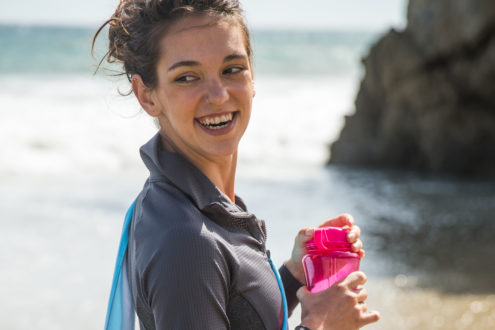Oftentimes, new clients will step into studios seeking leaner bodies. They want to ditch the flab and develop lean muscle mass. Pilates is designed to strengthen the powerhouse and develop a stronger mind/body connection, which will greatly assist in weight loss goals. While Pilates may not have the calorie-burning properties of cardiovascular exercise, it does develop the strength and awareness needed to keep clients on track toward a successful fitness journey.
For new clients coming to you seeking help with losing weight, there are a number of valuable tools to help set them off on the right path. But with hotter temperatures right around the corner, we thought it was appropriate to start with the most accessible weapon in our arsenal: water. In fact, it’s perhaps the strongest catalyst we have in fitness!
Find Out What’s What with Water
Hydration is essential for our survival and “thrive-al.” Every cell and tissue in our body needs water. After all, it makes up 60 to 70 percent of our bodies and plays a vital role in a number of essential functions1. There are so many, in fact, that we put in them in a handy list! Here are all of the key functions that would not happen without water:
- Regulating the body’s internal body temperature through sweat.
- Lubricating joints and cushioning organs throughout the body.
- Transporting glucose, oxygen and fats to working muscles
- Carrying away metabolic by-products like carbon dioxide and lactic acid.
- Getting rid of waste through urine.
- Digesting food through saliva and gastric secretions.
Last month, we explored what fruits and vegetables naturally help the hydration process. But typically, the average person does not eat enough servings of fruits and vegetables to supply sufficient fluid intake. We need to encourage our clients seeking weight loss solutions and healthier lifestyles to develop good drinking habits.
Developing Healthy Drinking Habits
There is a generally-held notion that since every food and beverage on this planet contains water, any food or beverage should be enough to stay hydrated. Unfortunately, drinks infused with additives like sugar, caffeine and carbonation trigger digestive and bodily reactions that demand higher amounts of fluid to process2. As a result, these kinds of beverages do not help us maintain healthy hydration levels like regular water does. In addition, water contains no calories and is extremely useful in suppressing appetite. So if your clients are looking to shed pounds this summer, recommend that they replace a lot of beverages with some old-fashioned, quality spring water.
Other diets geared toward quick weight loss can ignore the importance of hydration. For instance, when individuals severely restricts calories or certain nutrients like carbohydrates, the body will retain less fluids. This results in the immediate weight loss often seen in low-carb diets, but losing fluid is not an indicator of true weight loss success3. Real, desirable, and long-term weight loss involves actual fat loss, which typically occurs at a rate of about 1 pound per week with an energy deficit that is achieved through sound training and an appropriate diet.
So How Much Water is Enough?
Before we define how much water we need, we should first determine our current hydration level. The quickest way to determine your hydration is through urine color. Pale yellow to nearly clear is a great sign that you are well-hydrated. Dark yellow or amber-colored urine suggests that you need drink more fluid. Certain medications and vitamin supplements can darken a client’s urine color, but drinking an adequate amount of water should still alleviate that concern.
With our hydration levels in check, we need to determine how much water is enough to stay hydrated and perform at our best. A study completed by the Institute of Medicine in 2004 determined that an adequate intake is 13 cups (3 liters) of water for men and roughly 9 cups (2.2 liters) for women4. This study evolved into the easy-to-remember “8 by 8” rule, wherein people should drink 64 ounces of water per day by consuming eight, eight-ounce glasses of water. While that amount is a good starting point, proper hydration will depend on a individual’s weight and training regimen.
So for new clients seeking to lose weight, recommend that they start by drinking 64 ounces of plain old-fashioned water per day. Filling and drinking a 16-ounce bottle four times per day is a good way to start this positive habit. And remind students how important proper hydration is in their practice. Every muscle fiber and joint needs water to perform at its best, so remember to share these important facts with clients after class. It will help them leave their Pilates classes on the right path to a healthier life!



